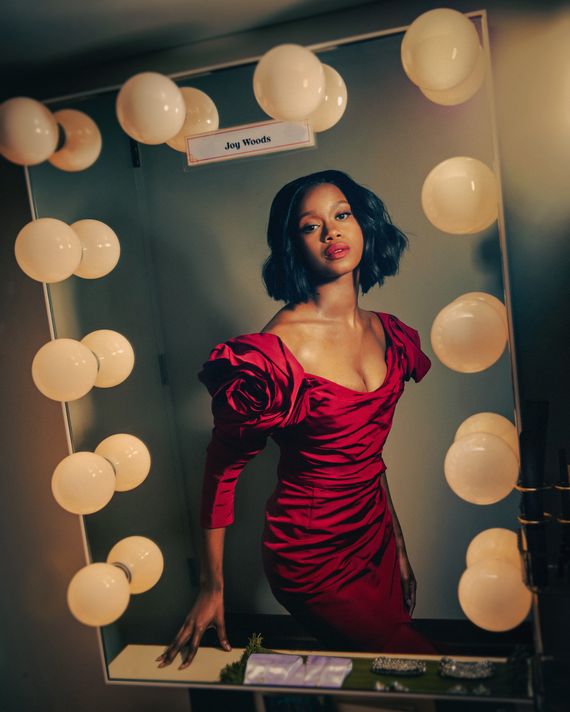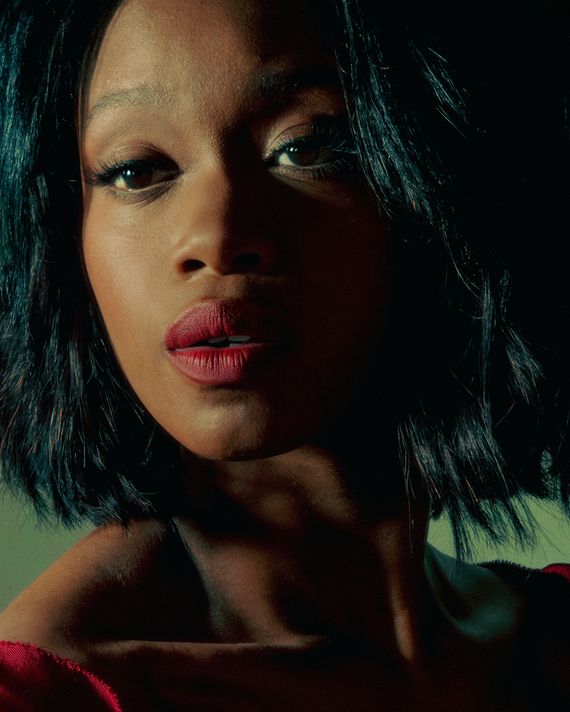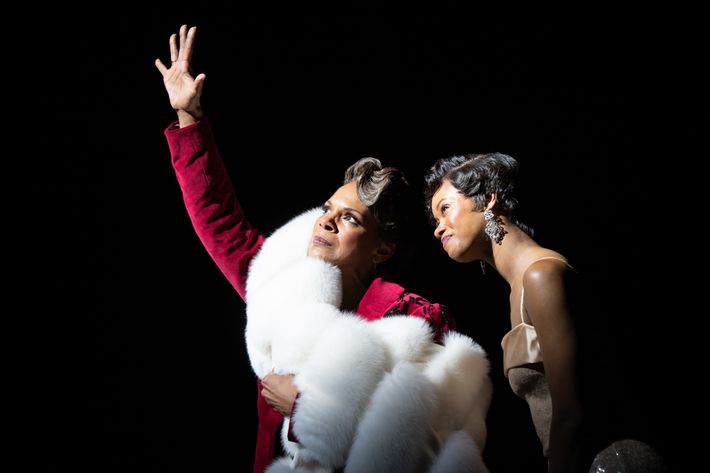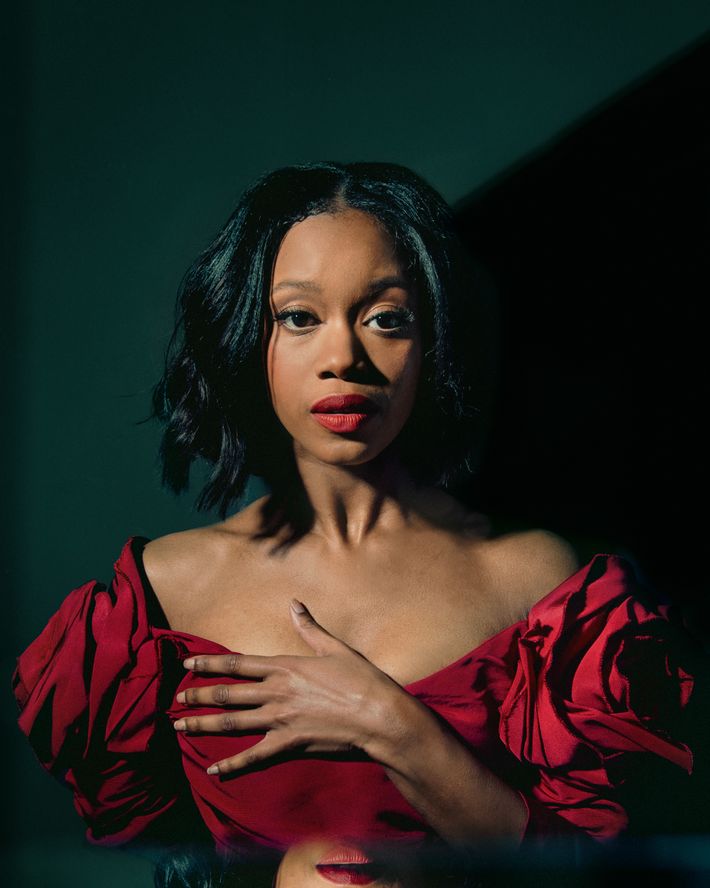
“They’re playing Six!” Joy Woods exclaims as we enter the Museum of Broadway. “Did you see it?” an older man asks. “Yes,” she replies. After he’s out of earshot, the former star of Six on Broadway whispers so only I can hear, “Did more than see it.” We’re at the museum before noon because, right after we finish, Woods has to rush to rehearsal for the latest revival of Gypsy, her next musical. She talks with the focused frenzy of someone about to run the biggest show of their career for the first time the day before previews begin. The previous night, Audra McDonald hugged her during a scene and one of the many bobby pins in Woods’s wig pricked her head, making her bleed. That wig changed. “I can’t tell if I’m still bleeding or not,” Woods says with a tired chuckle. I check, she’s not.
When Gypsy opens this month, Woods, 25, will star alongside McDonald — a six-time Tony winner considered perhaps the greatest musical-theater actress of all time — as the titular Gypsy Rose Lee, known throughout the show as Louise. Set in the early 20th century, Gypsy follows Mama Rose (McDonald) as she propels her daughters, June and Louise, into the vaudeville circuit through sheer determination, then through vaudeville’s decline. It’s a character study of Rose’s hyperfixation on the ebullient June’s career and her dismissal of the “talentless” Louise. By the end, however, it is Louise who becomes a star — not in vaudeville but as a stripper. It’s difficult to quantify how beloved Gypsy is: Frank Rich, in a 1984 New York Times essay, referred to it as “perhaps, to this day, the most perfectly achieved dance musical.” The last time it was on Broadway, in 2008, it won three acting Tonys: one for Patti LuPone as Mama Rose; another for Boyd Gaines as Rose’s love interest, Herbie; and a third for Laura Benanti in a star-making performance as Louise. It was the first time the role had won. “Louise cannot shrink,” Woods says when I ask her about the pressure. “That’s something I’m still finding in Joy.”
Woods has a thigh tattoo, one she got after a breakup, that reads “Trial by Fire” because, inadvertently, that has become her whole life. She has performed nonstop since she turned 19, becoming known for her powerful voice, which can adapt to both the vibrato-inflected, diaphragm-supported, classic musical-theater sound and the pop influence of modern Broadway, and for her ability to imbue her characters with an innate, unpretentious dignity. Her career began when she played Chiffon, a member of Little Shop of Horrors’s ’60s girl-group-style Greek chorus, in the show’s 2019 Off Broadway revival, alongside Jonathan Groff and Christian Borle. Then, in spring 2022, she made her Broadway debut in Six playing Catherine Parr. When she returned to Little Shop in spring 2023, she became the first Black Audrey in New York. During that run, a video of her singing Audrey’s signature ballad, “Somewhere That’s Green,” accompanied by Little Shop composer Alan Menken, went theater viral (it’s nearing 200,000 views on YouTube) because of her poised emotionality: Woods holds her composure throughout the song, then, at the end, two perfect teardrops fall down her face. It was a first take filmed while she was recovering from the flu; Woods wanted another shot at it, but the producers said they had what they needed.
Her real breakout came from starring as Middle Allie in The Notebook on Broadway earlier this year. Her 11 o’clock number, “My Days,” was all over TikTok — bootlegs of her performance have hundreds of thousands of likes on the app, with commenters marveling at the apparent ease with which she reaches, and belts, high notes. “In 15 years my kids are going to be jealous that I witnessed Joy Woods’ rise to Broadway stardom as it was happening,” one person wrote. It was one of the internet’s favorite theater moments of the year. Every time she opened TikTok, Woods would see “the back of someone’s throat” belting the song. “Sometimes it was mine,” she says. Gypsy, though, provides little opportunity for the belting that Woods is known for, relying instead on her ability to simply tell the story through song. “It’s such a rich, well-thought-out, well-written, put-together show that it doesn’t take much to do it wrong,” she says, adding that she’s been “feeling small in the presence of titans.”
Woods was raised outside Chicago as the youngest of six kids. Her dad worked in tech, while her mom, a former dancer, stayed home. She grew up going to a Black church, but their family left by the time she was old enough to join the choir. Through her older sisters, she started listening to Adele, Janelle Monáe, Katy Perry, and Natasha Bedingfield. “Those four gave me my voice,” Woods says. She loved movie musicals but wasn’t a theater kid until her sophomore year of high school, when a co-dancer on her poms team took her to the school’s production of The Addams Family. That’s when Woods resolved to be on Broadway, tweeting as much in 2016 before she had even been in any school musicals. When she did start acting, she booked leads. She decided to study musical theater, choosing the New York–based American Musical and Dramatic Academy because it gave her a scholarship.
Woods was at AMDA for a year, taking extra classes in the summer to accelerate the already-truncated two-year program. Her time there was terrible. “Until the last semester, when I was able to choose the things I wanted to do, I was given all songs sung by slaves,” she says. She was working at Junior’s in Times Square until three in the morning to make money, then trying to make an 8 a.m. ballet class that wouldn’t let her in if she was even a minute late. “I got called lazy and entitled by quite a few teachers, took a lot of hits in my confidence, did my best,” she says. “It was too much: depression, self-harm, all of the things you can imagine for a kid who was sheltered and now living in the city by themselves.” She failed ballet twice, and despite walking at graduation, she did not receive her certificate. It didn’t matter: She landed Little Shop while still in school and went to rehearsals from her dorm room. When people ask her for advice about AMDA now, she’s conflicted: “I’m like, ‘Do I play Princess Diana? Or do I play Whitney Houston and tell the truth?’”
Still, it was during her time there that she first heard about the legacy of Gypsy. She foggily remembered having watched the Bette Midler TV-movie version as a kid, but “the queens at AMDA” talked about the show with special reverence. She didn’t pay them much attention. “It was a golden-age musical and didn’t include people that looked like me, so I was like, Okay, that’s great,” she says. “Y’all can have that.” Woods’s production will be the first Broadway version of Gypsy to feature a Black family, but this is not “color-blind casting” — a phrase often incorrectly thrown around at shows like Hamilton that feature nontraditional but extremely intentional casting. The family’s Blackness is central to director George C. Wolfe’s vision. In his version, Rose’s neuroses are amplified by very real systemic racism, and her preference for June is heightened by the fact that the actress playing her (Jordan Tyson) is mixed race while Woods is a dark-skinned Black woman. Louise’s strips are also explicitly influenced by Josephine Baker. “There are a lot of things in this production that make it the Black Gypsy,” Woods says, “but they’re only really available to Black eyes.”
The audition process, predictably, was insane. Both the production and McDonald’s casting were announced in May 2024, but Louise and June weren’t revealed to the public until late September. During that time, “everybody and their mama went in” to audition, per Woods, and rumors about who would be Louise swirled throughout the Broadway community and online: Keke Palmer? Denée Benton? Joy Woods? Her agents had told her she was the only person going out for it; she believed it until she overheard a “voice that I know very well” performing the same material. Woods went to six work sessions with Wolfe before getting the part, the last of which was with McDonald. They performed the momentous dressing-room scene, in which Louise stands up to her mother for the first time, resulting in a screaming match. After one run sitting down, McDonald stood up, took her hair down, and suddenly they were getting the scene on its feet. “It was very scawy,” Woods says.
Woods is wildly self-critical. Often, if she starts a sentence talking about her strengths, she’ll find herself back at a critique by the time she’s finished. “There’s a power in stillness that I have honed in that I’m trying to break from,” she tells me after I ask her to describe herself as a performer. “I want the freedom to move.” McDonald sees that same groundedness in her but views it entirely as a strength. “That stillness allows her to drop all the way down to the bottom, and in ways she doesn’t see yet, I think it’s quite evident to audiences and to anyone observing her,” McDonald tells me.
Even when Woods arrives at Louise’s final version in the show, all Josephine Baker glamour and screaming at her mother, there’s still a sense of the hurt child within her. Woods is a remarkable reactor, and even from a distance, you can watch her take in information and slowly force herself to stomach it. Until she can’t. That final dressing-room scene, Woods says, has been her biggest challenge. “I haven’t been as present because I’ve been struggling to look like I’m present,” she tells me a few weeks into the show’s preview run. The previous night was the first time she had left the scene “not feeling like shit.” In real life, she’s not used to being angry. “I don’t yell,” she says. “I don’t go off on people. I don’t crash out.” While doing it in the audition room, she thought, This is what I sound like when I’m screaming. In performance, she’s had trouble with the pacing, often getting to the heights of her anger too late, when the script needs her to calm down, then leaving the theater with nowhere to put the anger and finding herself lying in bed unable to fall asleep. “I don’t think this is a place where she regularly lives,” Wolfe says. “But she found it. And it’s real, and it’s exciting.”
In The Notebook, which she was still performing for two weeks while rehearsing Gypsy, Woods was the one thing everybody seemed to like. She remembers the show getting a good reaction from the audience during previews, but it was a different story with critics. The New York Times dropped its review during the show’s opening-night party. It said the musical made “few convincing arguments for a separate existence” from the movie and called the whole affair “meretricious.” Woods read it in the taxi home. While her career was the only one that seemed to benefit from the show, owing to the success of “My Days” online, Woods says it felt like “survivor’s guilt of being airlifted out of a sinking ship.” When she thinks back, she says, “I’m grateful that I was held up in this way, but why wasn’t the piece? It seemed that a lot of the reviewers were coming looking to not like The Notebook.” Notably, Woods did not score a Tony nomination, which was exactly what she expected to happen. “I just got here,” she says. “One high belt song is not going to get me a Tony nom.”
As we proceed through the museum, Woods lingers for a bit in the burlesque section, which makes sense at first, given Louise’s arc. But it turns out Woods has a further connection: To make some extra money during the pandemic, she danced burlesque on the side for people who “were willing to wear masks and throw cash.” Her gimmick was furs. She danced for queer audiences, which felt good because she identifies as gay — though, she notes, “I dabble in men every now and then.” In 2019, Vogue posted a picture of her kissing her then-girlfriend at Pride on Instagram, and her cousin sent it to her parents, effectively outing her. Woods’s parents are “fine and supportive” now, she says, but it’s the kind of experience that can make a person leery. Burlesque was empowering, though. It was the only time she had created her own performance from scratch as opposed to waiting to be cast in another person’s idea. “It was a fun two years,” she says. “I was 21 and fearless.”
Having walked past countless theatrical divas on our tour of the museum — her favorites are the six women in red from Stephen Sondheim’s 80th-birthday concert, including LuPone, Bernadette Peters, Elaine Stritch, Donna Murphy, Marin Mazzie, and, of course, McDonald — the conversation turns toward where she wants her career to go from here. Woods is committed to theater. She also regularly refers to it as a “dying industry,” given its financial woes. “The goal for every show that you put up is to be delusional,” she says, “and be like, ‘This is the thing that’s going to bring theater back.’” When she watches those women in red dresses, which she often does, she imagines herself up there performing for a decadeslong collaborator. “Is that even something that I’m allowed to wish for?” she asks. “Is it going to exist by the time where I feel like I’m enough to be diva level?”





